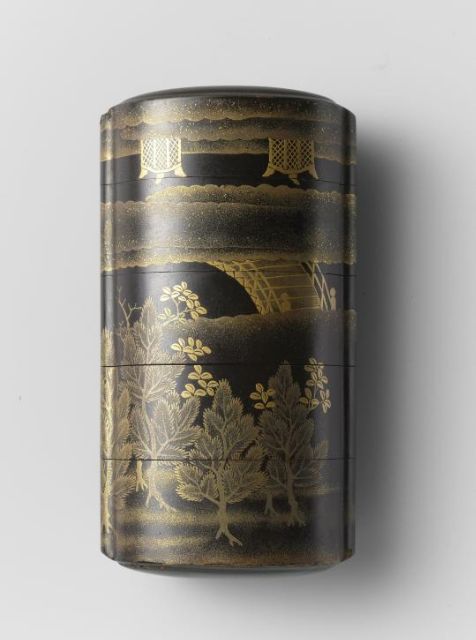…but earthenware
- Black Tea Canister
To reveal its true material: this object is made of a type of earthenware known as faience. Essentially, the terms refer to a tin-glazed ceramic, in this case with a rich black surface. Notice the chip in the surface that reveals the true color of the pottery. The terms faience and Delftware are used interchangeably.
When looking at images of lacquerware like the Japanese inro (small decorative box) and Chinese box [fig.1&2], it becomes clear what aesthetic was imitated. It was not necessarily about making the faience look as convincing as lacquerware by producing a genuine copy. Instead, the focus was on the representation and association with the ‘orient’ via shared stylistic and decorative elements.
Since the color black was fashionable at the time, the visual illusion did not come out of the blue. Essentially, Black Delftware provided the same precious and luxurious appearance associated with lacquerware. Although different in their material components, they offer a similar aesthetic. The creators successfully produced a lacquer-like glaze, akin to the smooth, shiny and hard surface of ‘real’ lacquered objects. When looking at the black Delftware pieces [fig.3&4], do you think the lacquer aesthetic was successfully captured?

Fig. 1: Anonymous, inro, black lacquer with a bridge in the fog and pine trees in maki-e, 1700 – 1800, Japan, wood, lacquer, gold, 9,5×5×3cm (h,w,d),, Rijksmuseum, Amsterdam, inv.nr. AK-NM-6173, http://hdl.handle.net/10934/RM0001.COLLECT.163103

Fig. 2: Anonymous, lacquer box with lid with mother-of-pearl and gold inlay, 1700, China, Qing- dynasty, lacquer, mother-of-pearl, 20,7× 27,5× 27,5 cm (h,d,w), Rijksmuseum, Amsterdam, inv.nr. AK-MAK-112, On loan from the Royal Society of Friends of Asian Art, http://hdl.handle.net/10934/RM0001.COLLECT.1895

Fig. 3: Anonymous, plate, c. 1700-1730, Delft, faience, 22,5 cm (d), Rijksmuseum Amsterdam, inv.nr. BK-NM-12400-267, donation from the heirs of Mr J.F. Loudon, The Hague, http://hdl.handle.net/10934/RM0001.COLLECT.16044

Fig. 4: De Metaale Pot, tea canister and lid, Delft, c. 1700-1724, Tin-glazed earthenware, painted in enamels, 10.2 × 5.7cm (h, w), Victoria and Albert museum, London, inv.nr. C.2346&A- 1910, https://collections.vam.ac.uk/item/O118502/tea-canister-and-metalen-pot-factory/